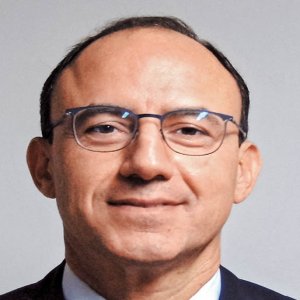Simultaneous Targets, Positive Results

STORY INLINE POST
Q: What are PEMEX’s health priorities for its beneficiaries in 2017?
A: As a healthcare provider, we have to focus on simultaneous targets. However, we began as a medical services company, so labor health is our main concern. We have doctors at every work site to deliver preventive care and promote health, hygiene, risk detection and to evaluate the compatibility of employees with the jobs they do. For example, some employees work 35-60 meters above a platform or land. They cannot su er from vertigo, have the flu or a high BMI because that would be risking their life. At PEMEX Health Services we are further ahead in health services than other industries such as automotive, pharmaceutical and aerospace. Our priority is to have our workers operating under the best conditions possible. Instead of building more hospitals, we want to focus our e orts on promoting preventive care. In fact, PEMEX has 41 health centers, including 10 first-class clinics, 24 hospitals and 168 preventive centers of labor health. Our hospitals are operating on average at 70 percent capacity.
Q: What are the main health concerns of PEMEX’s beneficiaries?
A: They are similar to Mexico’s main health issues: diabetes, cardiovascular diseases, obesity and systemic arterial disease. Our rates of diseases are low and the most common are usually hearing problems. We are a high-risk company, but we experience less than 0.2 accidents per million hours worked. There are many myths about PEMEX but we have one of the lowest sick leave rates among companies. Our workers take less than four sick days per year thanks to our preventive initiatives, our e ciency in setting appointments and the workers own commitment. The life expectancy of petroleum workers is 80 years, higher than Mexico’s average, which is 78. This is because they have increased access to health services. Therefore, we have many elderly patients; 56 percent of PEMEX’s beneficiaries are over 65 years old.
Q: What challenges does PEMEX face in retaining workers when faced with many new market entrants?
A: We need to o er the best benefits to our workers so they do not need to look for other employers. This year, we are also negotiating our collective bargaining agreement. We work closely with the union and it is committed to our focus on prevention and health promotion. We want both employer and employee to take responsibility for employee health. The paternalistic scheme in which the state or PEMEX provides everything to a passive beneficiary does not work. There should be a commitment from the employees, too. To this end, we have integrated a health bonus, which is given to workers with a BMI of less than 25 or for those who lose 10 kilos in a year. Their cholesterol and lipoproteins also must be in normal ranges and if they are already diabetic their glycohemoglobin must be under seven. If they comply they get the bonus.
Q: What relationship do you have with other public healthcare institutions?
A: President Peña Nieto and Minister Narro are working on the universalization of health services, which means that each institution has to be open to providing and receiving support from other institutions. We have an agreement with all the National Institutes of Health and we hire subrogated services in some other locations. We have partnerships with health institutions in Sonora, Aguascalientes, Tamaulipas and Veracruz. In cases of industrial emergencies, we receive a lot of support from IMSS. In 2016, when there was an emergency at our plant at Pajaritos, Veracruz, we received patients from IMSS because we had the largest coverage in the area. We also share successful experiences among institutions. In fact, every year we do a course on treating burn patients and we invite professionals from IMSS, SEDENA and SEMAR to take part because we are all part of the same ecosystem. We also have an agreement with the Ministry of Health to fumigate work areas to prevent vector-borne diseases and we provide them with fuel for their trucks.
Q: How did you manage the delegation of part of your services to a private insurance company?
A: There are smaller locations in which we have fewer than 120 workers but we are still obligated to provide health services. It would be very expensive for us to build a PEMEX hospital in those locations. From the beginning, we have hired private services to support those PEMEX locations that lack a health facility but which have active workers, or a total 104,000 beneficiaries. Two years ago, PEMEX’s supply department designed a strategy to have one health administrator instead of 95 providers. Unfortunately, the results were disappointing and we are now in the process of returning to our previous system.
Q: What opportunities do you o er students who want to do medical residencies in PEMEX hospitals? Which specialties are available to them?
A: Through PEMEX Health Services’s resident program we have trained high-quality and specialized professionals. We have schools at Hospital Central Sur de Alta Especialidad and Hospital Central Norte in Azcapotzalco, Mexico City; Hospital Regional Ciudad Madero, Tamaulipas and Hospital Regional de Salamanca, Guanajuato. There are 18 specialty and five subspecialty programs available for 388 students in the country. We are focused on the specialties we treat the most and for 10 years we have integrated successful students into the positions we need to fill.
Q: What are PEMEX’s main current health campaigns?
A: We have permanent programs to promote health, focused on child obesity, cervical and breast cancer for women and prenatal care. We also perform chronic degenerative diseases screenings, even in the workplace. We run a constant campaign on HIV and we treat around 700 cases, some of whom are active workers not on sick leave. We also run campaigns aligned with the Ministry of Health’s priorities on prevention of vector-borne diseases and teenage pregnancy. In addition, we have vaccinated almost 100 percent of 1-year olds. During pregnancy, we perform syphilis and HIV screenings as well as promoting contraceptive methods. We are also conducting an analysis of patients with hepatitis C to o er them new treatments.
Q: What are the benefits of digitalizing patient information?
A: We hold universal electronic records for direct and subrogated systems. The software was created by PEMEX 10 years ago for direct services and won the Innova award. Three years ago, we integrated it to the subrogated health services. When a doctor receives a patient, he has a password to access the patient’s data. The software is also linked to the labor health department and to a diabetes website on which doctors can create an alert when they recognize a diabetic patient. All this clinical information and laboratory data is also gathered to elaborate Big Data, which can be analyzed and presented in graphics to identify which patients, in which areas and in which positions have which diseases and find correlations.
Q: What is PEMEX’s contribution to Mexico’s growing clinical research industry?
A: We perform clinical trials to see which type of drugs and medical devices are best. In fact, two years ago we launched our molecular biology laboratory at the Hospital Central Sur de Alta Especialidad in Mexico City, where we are carrying out bacterial studies and soon will start a genetic study of the PEMEX population. We have an agreement with INMEGEN to know which diseases our beneficiaries are prone to and to identify the best drugs to treat them. In addition, we have a medical journal in which PEMEX health professionals publish articles and research papers. It is all part of our e ort in preventive medicine.






















